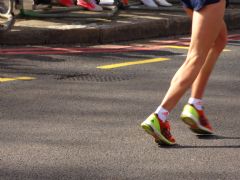Catching my breath & reorganising my life, ready to hit the road again (this time off to Helsinki for the European Championships a week on Monday), I thought I would write about one group of injuries that you'd expect to be less common than it actually is in athletics, the Lisfranc joint injuries.
To lay the foundations of this article, the Lisfranc joint complex comprises the articulation between the forefoot & the midfoot, a total of 6 articulations, weak dorsal ligaments & strong plantar ligaments & is so named after a field surgeon in Napoleon's army, Jacques Lisfranc, described an amputation involving the tarsometatarsal joint. Therefore, a Lisfranc injury does not describe one specific fracture or dislocation, moreover a spectrum of conditions involving the tarsometatarsal region.
Whilst historically Lisfranc injuries have been associated with high velocity/force, traumatic mechanisms, such as motor vehicle accidents or industrial injuries, the most commonly reported cases of sporting Lisfranc injuries are often related to non-traumatic, degenerative joint disease caused by repetitive twisting or turning actions, exposing a congenital or acquired deformity (e.g. first ray insufficiency, abnormal metatarsal parabola & equinus). These subsequently contribute a substantial proportion of the foot & ankle injuries reported in American Football, with Meyer et al (1994) reporting that Lisfranc injuries affected 4% of their collegiate football cohort, with the majority of those being offensive linemen.
More specifically, the Lisfranc ligament acts to secure the second metatarsal in the "keystone" of the midfoot & if subject to traumatic injury or associated fracture, deformity, instability, pain & degenerative joint disease can occur.
Lisfranc injuries are renowned to be challenging to diagnose, however, early & accurate diagnosis is crucial as outcomes worsen as any delay can result in persistent instability, deformity or arthritis. To this end an understanding of the anatomy, clinical presentation & mechanism of injury is, as with any other differential diagnosis, critical. Furthermore, one commonly reported factor in misdiagnosis, is the nature of the initial radigographic investigation, with Nunley & Vertullo (2002) reporting that 50% of cases initially imaged with a non-weight-bearing radiograph had an undetected diastasis, which was later revealed on weight-bearing films. To this end the authors recommend an initial radiographic study should comprise anteroposterior, 30 degree oblique & lateral views of the affected foot in addition to a weight-bearing view to detect any diastasis sustained.
In traumatic sporting cases, with the exception of crush trauma, Harwood & Raikin (2003) report that the mechanism of injury usually involves an axial longitudinal force applied to the foot in a plantar-flexed & slightly rotated position, followed by a forceful abduction or twisting movement. Any swelling will be reported in the toes & midfoot. If the weaker dorsal & interosseous ligaments fail at the tarsometatarsal joints, an associated dislocation may also be observed. In horse-riding, the mechanism usually involves a fall from the horse with the foot getting caught in the stirrups, whilst in gymnastics the injury is often sustained falling from the beam or vault. It is worth noting that the injury is relatively rare in dancers & this has been attributed to the higher level of training & subsequent greater muscle control of the feet.
Nunley & Vertullo (2002) classify Lisfranc injuries using a 3-stage system:
Stage I involves a sprain of the Lisfranc ligament, with no diastasis between the medial cuneiform & the base of the second metatarsal or loss of arch height apparent on weight-bearing radiographs. The Lisfranc complex is therefore seen to be stable, with a dorsal capsular tear & sprain not resulting in an elongation of the Lisfranc ligament.
Stage II involves a sprain of the Lisfranc ligament & an associated 1-5mm diastasis between the medial cuneiform & the base of the second metatarsal. Whilst the dorsal & interosseous ligaments are disrupted, there is no loss of arch height demonstrated on weight-bearing radiographs & whilst the Lisfranc ligament may be elongated or disrupted, the plantar capsular structures remain intact.
Stage III involves a sprain of the Lisfranc ligament with an associated diastasis of more than 5mm between the medial cuneiform & the base of the second metatarsal & a detectable drop in arch height on weight-bearing radiographs. In these instances, more significant displacement may be present & in these cases, the Myerson Classification should be used to stratify the injury.
The above classification may help guide additional radiographic studies, which may include:
- a bone scan to detect minor metabolic & blood flow changes if a Stage I injury is suspected
- a CT scan to assess fracture comminution in high-energy injury mechanisms
- an MRI to detect traumatic injury to the Lisfranc ligament
- abduction stress radiographs to detect subtle disastases
Conservative injury management may involve a progressive programme of non-weight-bearing immobilisation in a cast, immobilisation in a removable boot with progressive weight-bearing, custom moulded orthotics, manual therapy plus range of movement & foot strengthening exercises. The time-scales will be dependant on the nature of disruption & degree of displacement.
Some stage II & all stage III injuries will require open or arthroscopic surgical intervention, which will be guided by the extent of disruption observed.
The following papers are worth reviewing for further information:
- Aronow, MS. (2006). Treatment of the missed Lisfranc injury. Foot Ankle Clin; 11(1): pp127-142
- Chaney, DM. (2010). The Lisfranc joint. Clin Podiatr Med Surg; 27(4): pp547-60
- Crim, J. (2008). MR imaging evaluation of subtle Lisfranc injuries: the midfoot sprain. Magn Reson Imaging Clin N Amer; 16(1): pp19-27
- Hatem, SF. (2008). Imaging of Lisfranc injury & midfoot sprain. Radiol Clin N Am; 46(6): pp1045-1060
- Hunt, SA. et al (2006). Lisfranc joint injuries: diagnosis & treatment. Am J Orthop; 35(8): pp376-385

